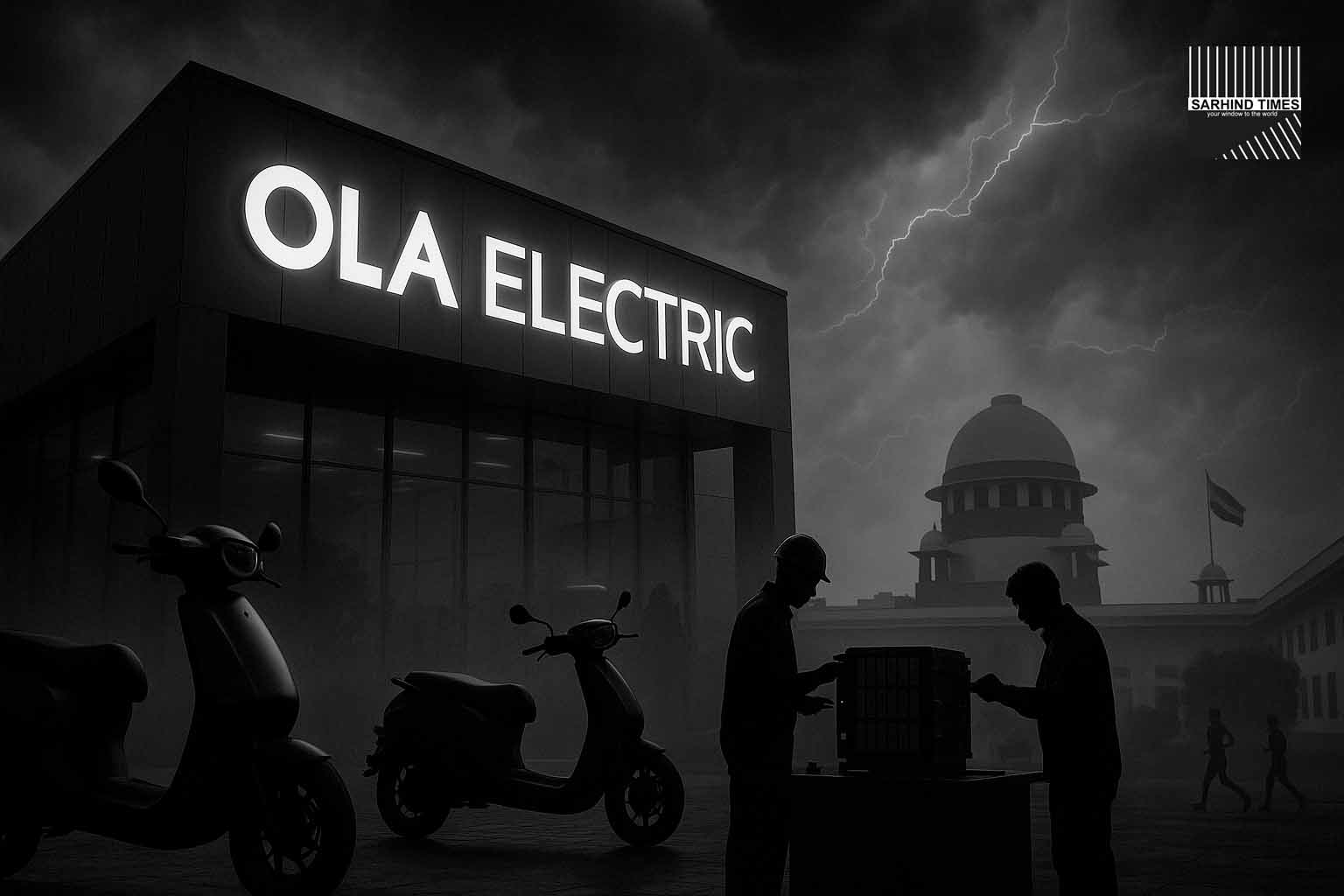Investors rally as the EV major hints at a major diversification into home and grid-scale energy solutions
(By Sarhind Times Business & Tech Bureau | Bengaluru | October 17, 2025)
Bengaluru — Buzz Builds Around Ola’s “Next Big Charge”
In a clear display of market confidence, Ola Electric Mobility’s shares hit the 5% upper circuit on Wednesday following its cryptic teaser for a new energy-focused product launch.
The company, which has rapidly evolved from an e-scooter manufacturer to an EV infrastructure player, announced via its official social channels that it will unveil an “energy innovation designed to power India’s future” later today.
The event, preponed from October 17 to October 16, has sparked widespread speculation that Ola may be gearing up to enter battery storage, home energy, or grid integration — expanding beyond vehicles into the broader energy ecosystem.
“Ola has consistently positioned itself as more than an EV maker. This move reinforces that ambition,” said Rajat Mahajan, senior analyst at Axis Securities. “The market is reading this as a signal of vertical integration — from mobility to energy infrastructure.”
A 5% Surge: Sentiment Meets Strategy
Ola Electric’s stock locked at the 5% upper circuit on the BSE, closing at ₹556.80, amid heavy trading volumes. Over 3.2 million shares changed hands — three times the daily average.
The rally reflects investor optimism around the company’s strategic shift toward the energy domain, seen as the next frontier for EV companies globally.
Analysts suggest the teaser could point to a multi-dimensional announcement:
- Battery packs or home storage solutions (akin to Tesla’s Powerwall).
- Grid services or V2G (vehicle-to-grid) technology leveraging its scooter and upcoming car ecosystem.
- Solar-charging or portable energy systems for households and small businesses.
“The timing before festival season, coupled with the domestic EV policy push, gives this launch symbolic and financial heft,” said Nirav Shah, fund manager, Kotak ESG Fund.
From Scooters to Storage: The Ola Evolution
Founded in 2017, Ola Electric began as a spin-off from Ola Cabs under founder Bhavish Aggarwal, with a vision to electrify India’s mobility landscape.
Since then, it has:
- Built India’s largest two-wheeler EV factory at Krishnagiri, Tamil Nadu.
- Rolled out EV scooters, S1 and S1 Pro, dominating the domestic e-scooter market.
- Developed Hypercharger networks for rapid two-wheeler charging.
- Invested heavily in cell manufacturing and research for indigenous battery production.
The new “energy” announcement suggests Ola is entering Phase 2.0 of its growth — energy autonomy.
“Mobility without energy independence is incomplete,” Bhavish Aggarwal said in a past investor note. “Our long-term mission is to democratize energy just as we did mobility.”
What the Market Is Betting On
While Ola Electric has not disclosed details, market circles are abuzz with three primary hypotheses:
1. Ola Home Energy Suite
A residential power solution integrating solar panels, smart batteries, and app-based control could align with India’s rooftop solar momentum.
- Why it makes sense: Ola’s EV user base already interacts with chargers and apps daily — a seamless ecosystem extension.
- Investor view: “Think of it as the Apple ecosystem but for clean energy,” said Vikram Nanda, EV venture capitalist.
2. Fast-Charging Infrastructure 2.0
Insiders speculate Ola may unveil an upgraded Hypercharge 2.0 network — higher capacity, AI-optimized charging stations enabling vehicle-to-grid (V2G) feedback.
- Why it matters: Grid-interactive charging reduces pressure on utilities and creates new monetization channels.
3. Battery Swap or Energy-as-a-Service (EaaS)
A modular battery swap system could target fleet vehicles, rural users, or delivery segments — building recurring revenue streams.
“This would transform Ola into a mobility + energy utility hybrid,” noted Indira Raj, energy analyst at Bernstein India.
Global Parallels: The Tesla & BYD Playbook
Ola’s expansion echoes strategies adopted by global peers:
| Company | Energy Initiatives | Impact |
| Tesla (USA) | Powerwall, Powerpack, Megapack | Energy revenues crossed $10B in FY24 |
| BYD (China) | Grid services, solar-battery solutions | Dominates Asia’s energy storage market |
| NIO (China) | Battery swapping & storage | 2,300+ swap stations nationwide |
| Ola Electric (India) | EV + clean energy integration (expected) |
India’s rapid electrification drive under “Make in India” and National Energy Storage Mission positions Ola at the intersection of mobility, manufacturing, and energy sovereignty.
“If Ola can deliver homegrown battery tech and grid-linked solutions, it could become India’s Tesla equivalent,” said Anand Mahindra in a social media post congratulating the company’s trajectory.
The Investment Story: Bullish but Cautious
Brokerages remain cautiously optimistic, emphasizing execution over hype.
- Valuation Impact: Short-term rally possible, but sustainability depends on clarity around business model and scalability.
- R&D Expenditure: Analysts estimate Ola has invested over ₹1,200 crore in battery and energy R&D since 2022.
- Revenue Diversification: Expanding into the energy domain could reduce dependence on scooter sales and improve margins.
“If executed right, this could shift Ola’s identity from a product company to an energy ecosystem brand,” said Abhishek Jain, lead researcher at Motilal Oswal.
Government Policy Tailwinds
The timing coincides with India’s National Green Hydrogen Mission, PLI schemes for advanced cell manufacturing, and EV Infra subsidies.
- Policy Synergy: Energy storage and renewable integration enjoy strong fiscal incentives.
- Strategic Relevance: With India’s power demand growing 8% annually, distributed energy systems are being fast-tracked.
“Ola’s alignment with India’s renewable roadmap could qualify it for multiple incentive streams,” said Dr. Ritu Mahajan, policy advisor at NITI Aayog.
Technology Focus: Vertical Integration in Motion
Industry insiders suggest Ola’s upcoming launch may integrate three verticals:
- Ola Cell Tech: In-house battery cells optimized for long lifecycle and faster charging.
- Ola Grid: AI-based energy management linking homes, chargers, and fleet networks.
- Ola Energy Cloud: Data analytics backbone optimizing energy storage, discharge, and consumption.
This would mirror Tesla’s energy grid logic, allowing Ola to monetize not just EVs, but kilowatts and data.
Market Snapshot
| Stock | Price | Change | Volume |
| Ola Electric Mobility | ₹556.80 | +5% (Upper Circuit) | 3.2M shares |
| TVS Motor Co. | ₹2,048 | -0.8% | 1.5M |
| Tata Motors | ₹1,048 | +0.6% | 2.7M |
| Hero MotoCorp | ₹4,852 | +0.2% | 1.1M |
Investors are treating the rally as a “pre-announcement trade”, a familiar pattern in the tech sector where speculation drives momentum ahead of product reveals.
Challenges on the Horizon
While enthusiasm is palpable, Ola faces significant challenges:
- Battery Reliability: Long-term performance consistency remains under scrutiny.
- After-Sales Network: Scaling support for nationwide rollout requires capital-intensive expansion.
- Consumer Trust: Early scooter glitches dented reputation; recovery depends on proven reliability.
- Competition: Global majors like Tata Power, Reliance New Energy, and Exide are racing to capture the same clean-energy space.
“Innovation must be matched by dependability,” warned Dr. Ajay Mathur, Director General of the International Solar Alliance.
The Bhavish Aggarwal Factor
At the heart of Ola’s transformation lies its founder — Bhavish Aggarwal, often compared to Elon Musk for his vision-driven entrepreneurship.
Aggarwal has publicly stated that Ola’s mission is to ‘reimagine energy for a billion people’, combining mobility, sustainability, and self-reliance.
His earlier initiatives — from Gigafactory plans in Krishnagiri to indigenous motor controllers — reflect a pattern of vertical integration.
“India must own its energy future. We can’t import our way into sustainability,” Aggarwal said at a 2024 investors’ summit.
Analyst Outlook: Short-Term Volatility, Long-Term Play
Equity strategists expect near-term volatility as hype settles post-announcement.
However, the structural growth story remains intact, anchored by:
- India’s accelerating EV adoption (CAGR 40%+).
- Global battery storage boom.
- Integration of EVs, renewables, and grid tech.
“If Ola’s energy launch adds tangible utility beyond branding, the stock could see sustained re-rating,” noted Deepali Verma, senior strategist at HDFC Securities.
The Larger Picture: India’s Energy Moment
India is witnessing an energy revolution—solar rooftops, EVs, hydrogen, and AI-powered grids. Ola’s diversification, if successful, could bridge the gap between personal mobility and national energy resilience.
“It’s not just about e-scooters anymore,” said Dr. Ramesh Kumar, IIT Madras energy economist. “It’s about who controls the electrons that move them.”
The upcoming launch, therefore, represents not just a corporate milestone, but a symbol of India’s industrial evolution — from manufacturing machines to manufacturing momentum.
Conclusion: The Charge Ahead
As Ola Electric prepares to lift the veil on its mysterious “energy” product, all eyes — from investors to policymakers — are on how it redefines the intersection of mobility, energy, and innovation.
Whether it’s a battery breakthrough, home-energy suite, or charging revolution, the message is clear: Ola is not just building vehicles, it’s building an ecosystem.
In a decade defined by sustainability and electrification, the company’s new venture could decide whether India leads the energy transition or follows it.
For now, the market has already cast its vote — and it’s bullish.
#OlaElectric #EV #CleanEnergy #Batteries #MakeInIndia #StockMarket #Tech #Innovation #Sustainability #EnergyTransition #GreenTech #Mobility





















+ There are no comments
Add yours